Air Pollution Impact on Aboriginals Australia: Health Risk Assessment
VerifiedAdded on 2022/12/26
|15
|3719
|56
Report
AI Summary
This report presents an environmental health risk assessment (EHRA) focused on the impact of air pollution on the respiratory health of Aboriginal Australians. The study begins with an executive summary and introduction, establishing the context of poorer health outcomes experienced by Indigenous populations compared to other Australians, specifically addressing the disproportionate burden of disease related to environmental factors. The research formulates specific research questions, employing the PICO framework to investigate the proportion of the population affected, intervention procedures, comparative health outcomes, and related health outcomes. The background information provides context, highlighting environmental risk factors like air pollution and their effects on respiratory ailments, supported by a review of relevant literature. The methodology section outlines the approach to problem identification, hazard identification (particulate matter, exhaust, smoking), dose-response relationships, and exposure assessment. The report also includes a strategic framework for risk communication, detailing goals, target audiences, and key principles to improve health outcomes. The study concludes by synthesizing the findings and recommendations for future research and intervention strategies.
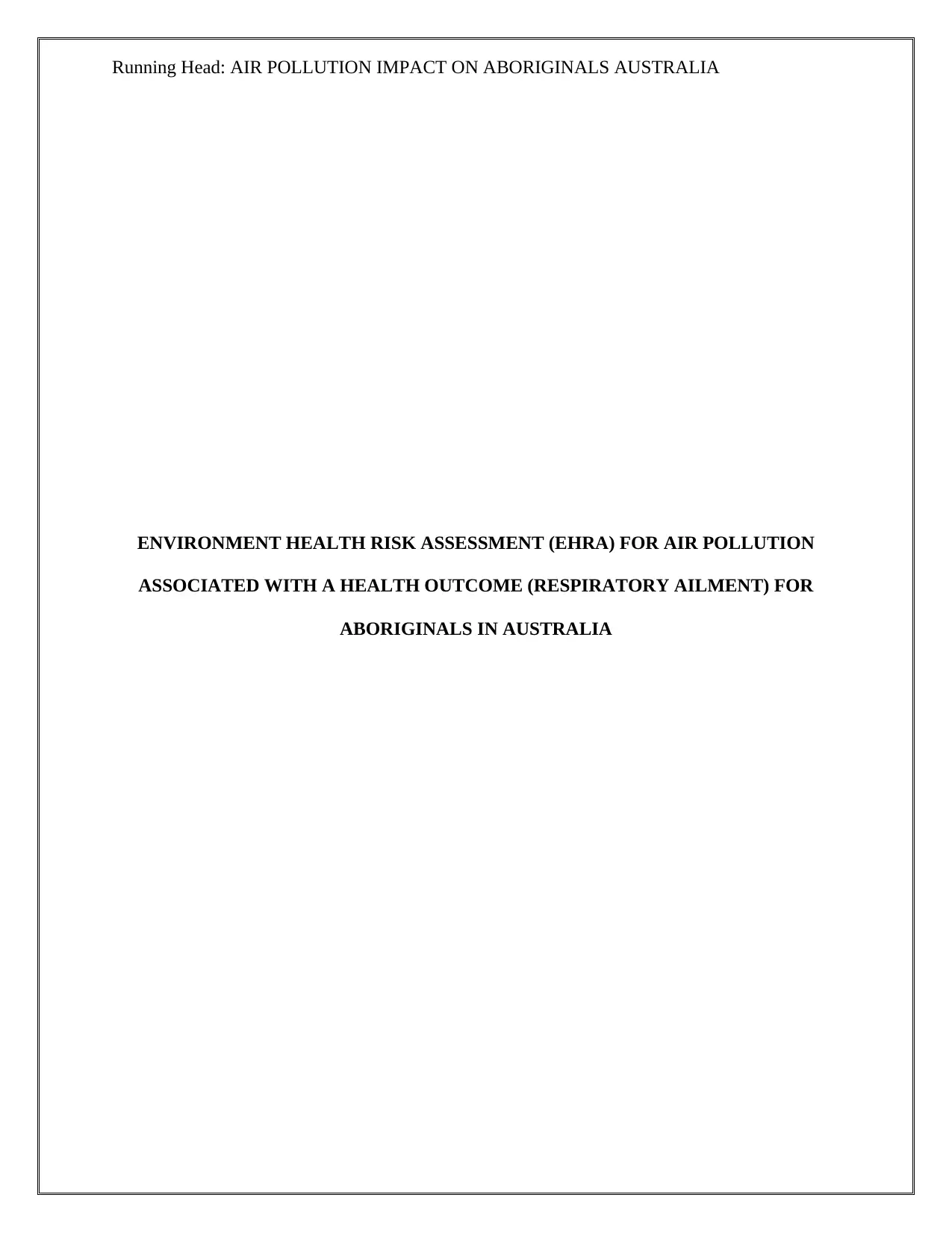
Running Head: AIR POLLUTION IMPACT ON ABORIGINALS AUSTRALIA
ENVIRONMENT HEALTH RISK ASSESSMENT (EHRA) FOR AIR POLLUTION
ASSOCIATED WITH A HEALTH OUTCOME (RESPIRATORY AILMENT) FOR
ABORIGINALS IN AUSTRALIA
ENVIRONMENT HEALTH RISK ASSESSMENT (EHRA) FOR AIR POLLUTION
ASSOCIATED WITH A HEALTH OUTCOME (RESPIRATORY AILMENT) FOR
ABORIGINALS IN AUSTRALIA
Paraphrase This Document
Need a fresh take? Get an instant paraphrase of this document with our AI Paraphraser
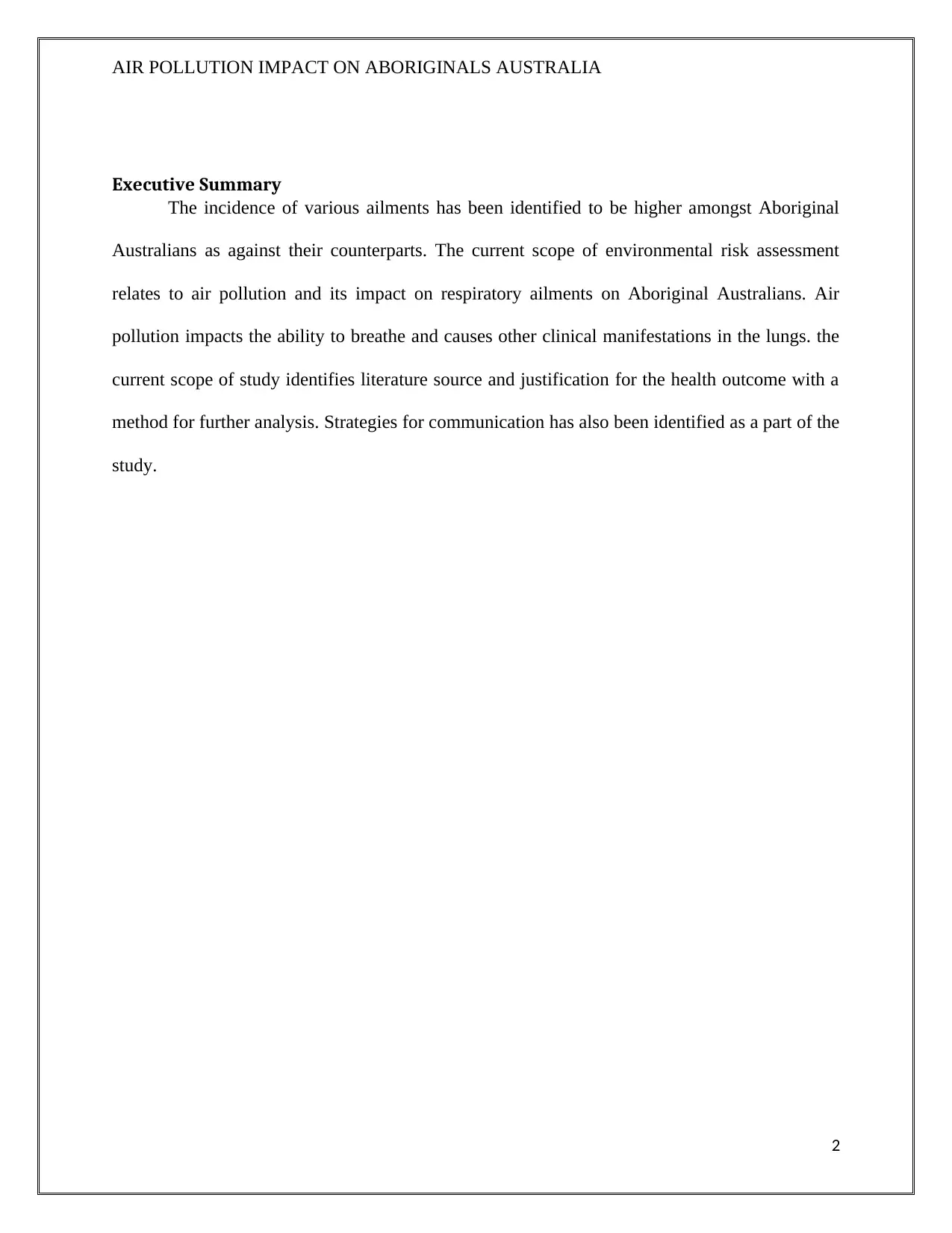
AIR POLLUTION IMPACT ON ABORIGINALS AUSTRALIA
Executive Summary
The incidence of various ailments has been identified to be higher amongst Aboriginal
Australians as against their counterparts. The current scope of environmental risk assessment
relates to air pollution and its impact on respiratory ailments on Aboriginal Australians. Air
pollution impacts the ability to breathe and causes other clinical manifestations in the lungs. the
current scope of study identifies literature source and justification for the health outcome with a
method for further analysis. Strategies for communication has also been identified as a part of the
study.
2
Executive Summary
The incidence of various ailments has been identified to be higher amongst Aboriginal
Australians as against their counterparts. The current scope of environmental risk assessment
relates to air pollution and its impact on respiratory ailments on Aboriginal Australians. Air
pollution impacts the ability to breathe and causes other clinical manifestations in the lungs. the
current scope of study identifies literature source and justification for the health outcome with a
method for further analysis. Strategies for communication has also been identified as a part of the
study.
2

AIR POLLUTION IMPACT ON ABORIGINALS AUSTRALIA
Table of Contents
Executive Summary.........................................................................................................................2
Introduction......................................................................................................................................4
Research Question...........................................................................................................................4
Background information..................................................................................................................5
Methods...........................................................................................................................................8
Strategy for the risk communication................................................................................................9
Conclusion.....................................................................................................................................11
References......................................................................................................................................12
3
Table of Contents
Executive Summary.........................................................................................................................2
Introduction......................................................................................................................................4
Research Question...........................................................................................................................4
Background information..................................................................................................................5
Methods...........................................................................................................................................8
Strategy for the risk communication................................................................................................9
Conclusion.....................................................................................................................................11
References......................................................................................................................................12
3
⊘ This is a preview!⊘
Do you want full access?
Subscribe today to unlock all pages.

Trusted by 1+ million students worldwide

AIR POLLUTION IMPACT ON ABORIGINALS AUSTRALIA
Introduction
Accessing clean air, water, soil, and food in a sustainable manner is the basic tenet of
human health (Bell, Ebisu, Peng & Dominici, 2009). The indigenous population is seen to
experience poorer health as compared to other Australians. In absence, the basic amenities,
inequality, and diseases can manifest and perpetuate unchecked. The world is confronted with
the stark reality that a sizable population proportion has infrequent or no access to sanitation,
clean air or breathing poses potential dangers. Dangerous levels of vehicle and industrial
emissions possess vulnerability to children and adults. Indigenous people throughout the globe
bears a disproportionate share of the disease burden (Zhang & Batterman, 2013). Especially the
Aboriginal and Torres Strait Islander bear tremendous high burden from environmental air
pollution. There are complex reasons attributed to such burden of disease. The current research
involves environmental health risk assessment (EHRA) for an environmental pollutant, which is
air pollution, with a health outcome for a specified population, here which here is analyzed to be
Aboriginal Australians. The specific health outcome includes respiratory ailments.
Research Question
The scope of this study will aim to answer the following research questions.
Research Question 1: P- What proportion of the population is affected due to air pollution?
Research Question 2: I – What is the intervention procedure used for the health outcome?
Research Question 3: C – How can health outcome of aboriginals be compared with other
Australians?
Research Question 4: O – What is the health-related outcome for the healthy population?
4
Introduction
Accessing clean air, water, soil, and food in a sustainable manner is the basic tenet of
human health (Bell, Ebisu, Peng & Dominici, 2009). The indigenous population is seen to
experience poorer health as compared to other Australians. In absence, the basic amenities,
inequality, and diseases can manifest and perpetuate unchecked. The world is confronted with
the stark reality that a sizable population proportion has infrequent or no access to sanitation,
clean air or breathing poses potential dangers. Dangerous levels of vehicle and industrial
emissions possess vulnerability to children and adults. Indigenous people throughout the globe
bears a disproportionate share of the disease burden (Zhang & Batterman, 2013). Especially the
Aboriginal and Torres Strait Islander bear tremendous high burden from environmental air
pollution. There are complex reasons attributed to such burden of disease. The current research
involves environmental health risk assessment (EHRA) for an environmental pollutant, which is
air pollution, with a health outcome for a specified population, here which here is analyzed to be
Aboriginal Australians. The specific health outcome includes respiratory ailments.
Research Question
The scope of this study will aim to answer the following research questions.
Research Question 1: P- What proportion of the population is affected due to air pollution?
Research Question 2: I – What is the intervention procedure used for the health outcome?
Research Question 3: C – How can health outcome of aboriginals be compared with other
Australians?
Research Question 4: O – What is the health-related outcome for the healthy population?
4
Paraphrase This Document
Need a fresh take? Get an instant paraphrase of this document with our AI Paraphraser
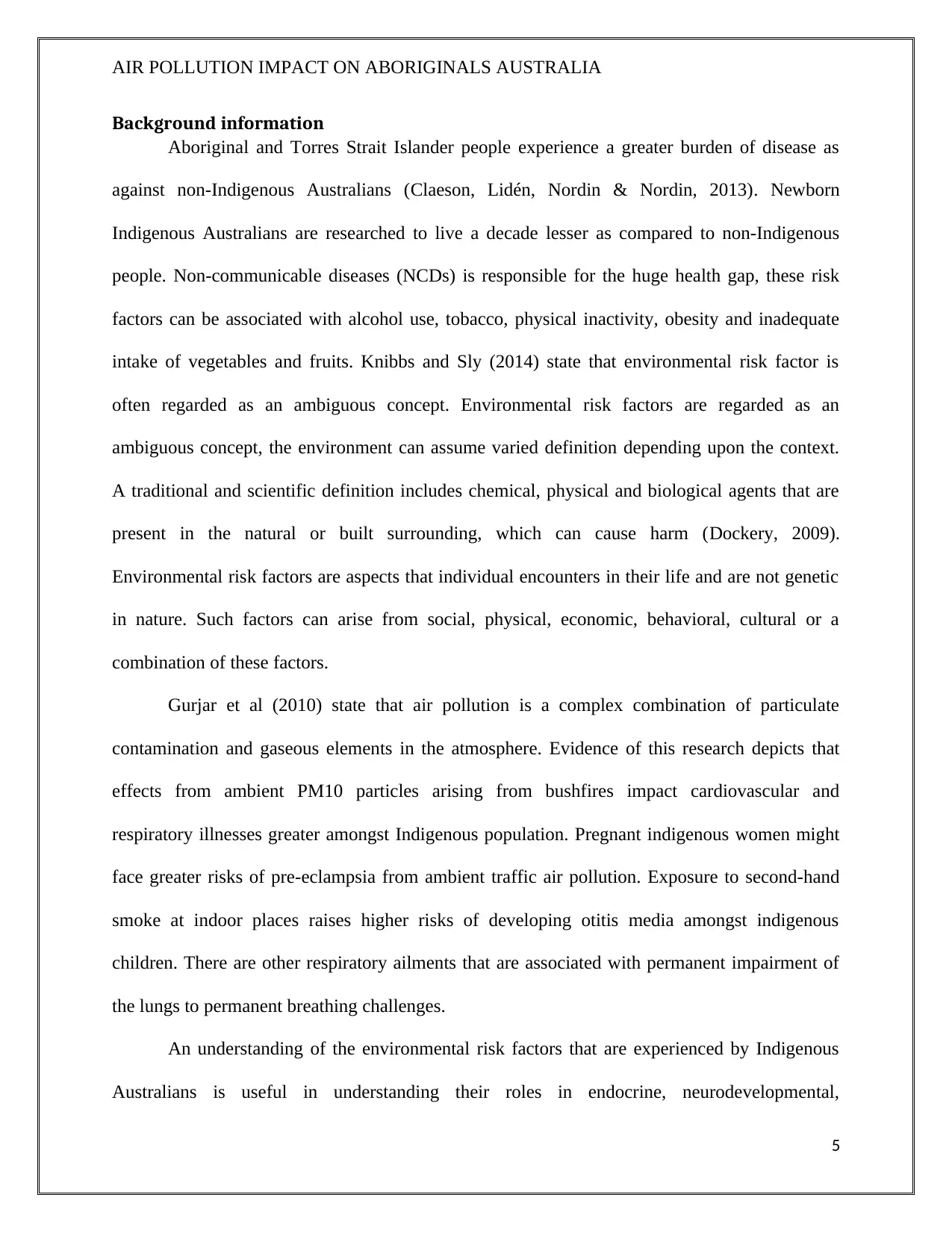
AIR POLLUTION IMPACT ON ABORIGINALS AUSTRALIA
Background information
Aboriginal and Torres Strait Islander people experience a greater burden of disease as
against non-Indigenous Australians (Claeson, Lidén, Nordin & Nordin, 2013). Newborn
Indigenous Australians are researched to live a decade lesser as compared to non-Indigenous
people. Non-communicable diseases (NCDs) is responsible for the huge health gap, these risk
factors can be associated with alcohol use, tobacco, physical inactivity, obesity and inadequate
intake of vegetables and fruits. Knibbs and Sly (2014) state that environmental risk factor is
often regarded as an ambiguous concept. Environmental risk factors are regarded as an
ambiguous concept, the environment can assume varied definition depending upon the context.
A traditional and scientific definition includes chemical, physical and biological agents that are
present in the natural or built surrounding, which can cause harm (Dockery, 2009).
Environmental risk factors are aspects that individual encounters in their life and are not genetic
in nature. Such factors can arise from social, physical, economic, behavioral, cultural or a
combination of these factors.
Gurjar et al (2010) state that air pollution is a complex combination of particulate
contamination and gaseous elements in the atmosphere. Evidence of this research depicts that
effects from ambient PM10 particles arising from bushfires impact cardiovascular and
respiratory illnesses greater amongst Indigenous population. Pregnant indigenous women might
face greater risks of pre-eclampsia from ambient traffic air pollution. Exposure to second-hand
smoke at indoor places raises higher risks of developing otitis media amongst indigenous
children. There are other respiratory ailments that are associated with permanent impairment of
the lungs to permanent breathing challenges.
An understanding of the environmental risk factors that are experienced by Indigenous
Australians is useful in understanding their roles in endocrine, neurodevelopmental,
5
Background information
Aboriginal and Torres Strait Islander people experience a greater burden of disease as
against non-Indigenous Australians (Claeson, Lidén, Nordin & Nordin, 2013). Newborn
Indigenous Australians are researched to live a decade lesser as compared to non-Indigenous
people. Non-communicable diseases (NCDs) is responsible for the huge health gap, these risk
factors can be associated with alcohol use, tobacco, physical inactivity, obesity and inadequate
intake of vegetables and fruits. Knibbs and Sly (2014) state that environmental risk factor is
often regarded as an ambiguous concept. Environmental risk factors are regarded as an
ambiguous concept, the environment can assume varied definition depending upon the context.
A traditional and scientific definition includes chemical, physical and biological agents that are
present in the natural or built surrounding, which can cause harm (Dockery, 2009).
Environmental risk factors are aspects that individual encounters in their life and are not genetic
in nature. Such factors can arise from social, physical, economic, behavioral, cultural or a
combination of these factors.
Gurjar et al (2010) state that air pollution is a complex combination of particulate
contamination and gaseous elements in the atmosphere. Evidence of this research depicts that
effects from ambient PM10 particles arising from bushfires impact cardiovascular and
respiratory illnesses greater amongst Indigenous population. Pregnant indigenous women might
face greater risks of pre-eclampsia from ambient traffic air pollution. Exposure to second-hand
smoke at indoor places raises higher risks of developing otitis media amongst indigenous
children. There are other respiratory ailments that are associated with permanent impairment of
the lungs to permanent breathing challenges.
An understanding of the environmental risk factors that are experienced by Indigenous
Australians is useful in understanding their roles in endocrine, neurodevelopmental,
5
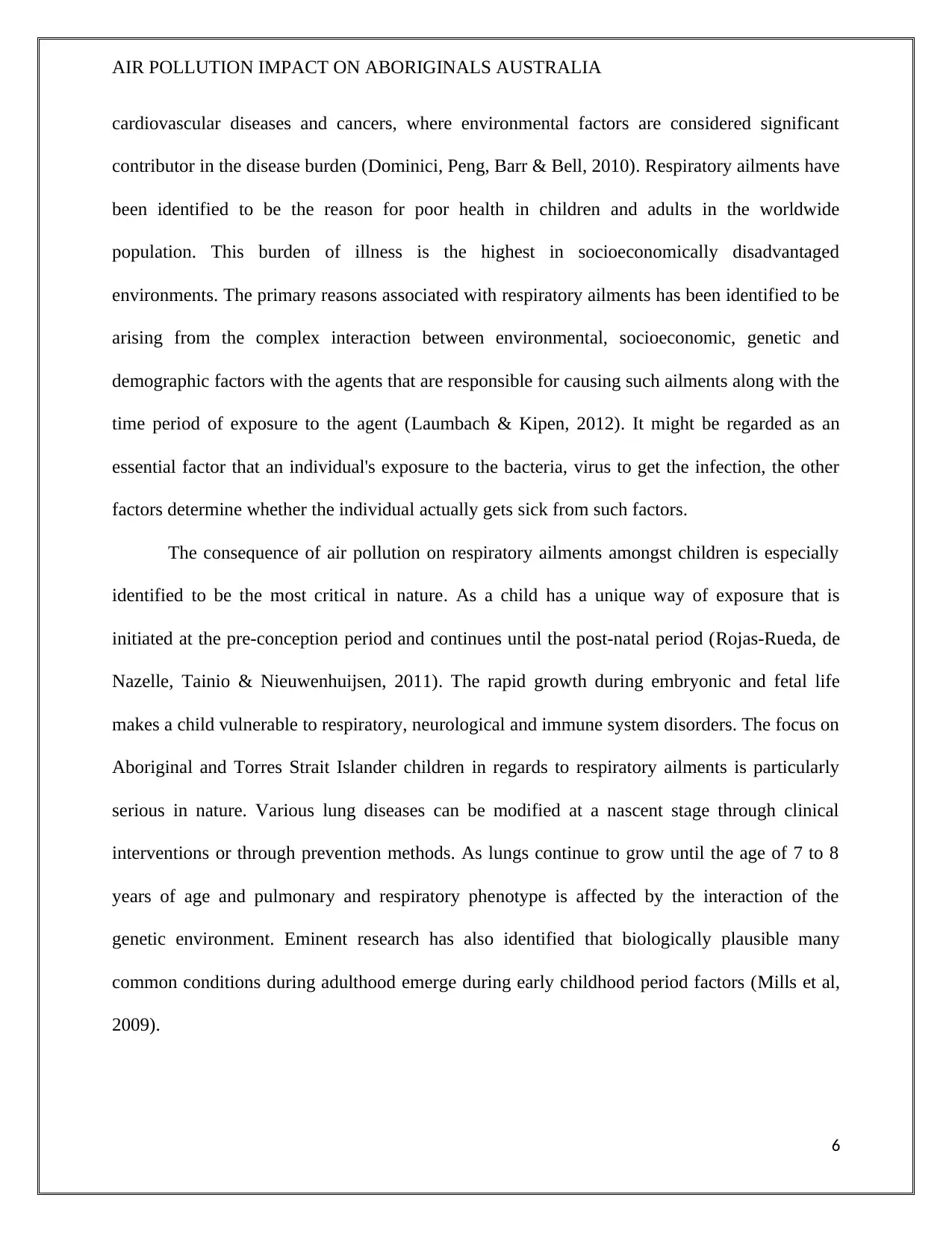
AIR POLLUTION IMPACT ON ABORIGINALS AUSTRALIA
cardiovascular diseases and cancers, where environmental factors are considered significant
contributor in the disease burden (Dominici, Peng, Barr & Bell, 2010). Respiratory ailments have
been identified to be the reason for poor health in children and adults in the worldwide
population. This burden of illness is the highest in socioeconomically disadvantaged
environments. The primary reasons associated with respiratory ailments has been identified to be
arising from the complex interaction between environmental, socioeconomic, genetic and
demographic factors with the agents that are responsible for causing such ailments along with the
time period of exposure to the agent (Laumbach & Kipen, 2012). It might be regarded as an
essential factor that an individual's exposure to the bacteria, virus to get the infection, the other
factors determine whether the individual actually gets sick from such factors.
The consequence of air pollution on respiratory ailments amongst children is especially
identified to be the most critical in nature. As a child has a unique way of exposure that is
initiated at the pre-conception period and continues until the post-natal period (Rojas-Rueda, de
Nazelle, Tainio & Nieuwenhuijsen, 2011). The rapid growth during embryonic and fetal life
makes a child vulnerable to respiratory, neurological and immune system disorders. The focus on
Aboriginal and Torres Strait Islander children in regards to respiratory ailments is particularly
serious in nature. Various lung diseases can be modified at a nascent stage through clinical
interventions or through prevention methods. As lungs continue to grow until the age of 7 to 8
years of age and pulmonary and respiratory phenotype is affected by the interaction of the
genetic environment. Eminent research has also identified that biologically plausible many
common conditions during adulthood emerge during early childhood period factors (Mills et al,
2009).
6
cardiovascular diseases and cancers, where environmental factors are considered significant
contributor in the disease burden (Dominici, Peng, Barr & Bell, 2010). Respiratory ailments have
been identified to be the reason for poor health in children and adults in the worldwide
population. This burden of illness is the highest in socioeconomically disadvantaged
environments. The primary reasons associated with respiratory ailments has been identified to be
arising from the complex interaction between environmental, socioeconomic, genetic and
demographic factors with the agents that are responsible for causing such ailments along with the
time period of exposure to the agent (Laumbach & Kipen, 2012). It might be regarded as an
essential factor that an individual's exposure to the bacteria, virus to get the infection, the other
factors determine whether the individual actually gets sick from such factors.
The consequence of air pollution on respiratory ailments amongst children is especially
identified to be the most critical in nature. As a child has a unique way of exposure that is
initiated at the pre-conception period and continues until the post-natal period (Rojas-Rueda, de
Nazelle, Tainio & Nieuwenhuijsen, 2011). The rapid growth during embryonic and fetal life
makes a child vulnerable to respiratory, neurological and immune system disorders. The focus on
Aboriginal and Torres Strait Islander children in regards to respiratory ailments is particularly
serious in nature. Various lung diseases can be modified at a nascent stage through clinical
interventions or through prevention methods. As lungs continue to grow until the age of 7 to 8
years of age and pulmonary and respiratory phenotype is affected by the interaction of the
genetic environment. Eminent research has also identified that biologically plausible many
common conditions during adulthood emerge during early childhood period factors (Mills et al,
2009).
6
⊘ This is a preview!⊘
Do you want full access?
Subscribe today to unlock all pages.

Trusted by 1+ million students worldwide

AIR POLLUTION IMPACT ON ABORIGINALS AUSTRALIA
Historically the colonization and further negative impacts on the Aboriginal community has
brought about a number of impacts on the community. One of the leading impacts is reducing
access to health facilities. The Aboriginals and Indigenous people in Australia still lack access to
proper medical and health facilities. Moreover, lack of awareness and ignorance causes
significant health impacts. Kelly and Fussell (2015) identify that the fine particulate matters and
hazardous substances have the capability to impact the lungs of both adults and children. These
matters have the capability to block breathing trackways and causing infections, which if left
untreated might have other clinical manifestations. Children in the Aboriginal and Indigenous
communities are more exposed to such fine particles and hazardous substances due to the
communities lifestyles and trends. For example, the Aboriginal community still makes extensive
use of coal while cooking. Smoking is common within males and females of this community.
Therefore, lifestyle and cultural factors contribute significantly towards an increased incidence of
this disease.
Another pertinent factor found was the place of Aboriginal residence, though spread
through different regions in Australia, yet concentrated to various mining sites. The Aboriginal
member communities have not much dislocated and their earlier settlements were near resources
(Harlan & Ruddell, 2011). Hence these resource sites have now translated into mining sites,
where companies excavate various elements for business purpose. Aboriginal settlement in such
regions and their inability to relocate has led to another major challenge in the particular health
outcome. Unavailability of economic resources has led to these community members inability to
shift their place of residence, hence the children and adults of the community inhale toxic fumes
from these mining sites. This is another pertinent factor that leads to a high incidence of
respiratory ailments amongst Aboriginal adult and children (White, 2013). However, in spite of
7
Historically the colonization and further negative impacts on the Aboriginal community has
brought about a number of impacts on the community. One of the leading impacts is reducing
access to health facilities. The Aboriginals and Indigenous people in Australia still lack access to
proper medical and health facilities. Moreover, lack of awareness and ignorance causes
significant health impacts. Kelly and Fussell (2015) identify that the fine particulate matters and
hazardous substances have the capability to impact the lungs of both adults and children. These
matters have the capability to block breathing trackways and causing infections, which if left
untreated might have other clinical manifestations. Children in the Aboriginal and Indigenous
communities are more exposed to such fine particles and hazardous substances due to the
communities lifestyles and trends. For example, the Aboriginal community still makes extensive
use of coal while cooking. Smoking is common within males and females of this community.
Therefore, lifestyle and cultural factors contribute significantly towards an increased incidence of
this disease.
Another pertinent factor found was the place of Aboriginal residence, though spread
through different regions in Australia, yet concentrated to various mining sites. The Aboriginal
member communities have not much dislocated and their earlier settlements were near resources
(Harlan & Ruddell, 2011). Hence these resource sites have now translated into mining sites,
where companies excavate various elements for business purpose. Aboriginal settlement in such
regions and their inability to relocate has led to another major challenge in the particular health
outcome. Unavailability of economic resources has led to these community members inability to
shift their place of residence, hence the children and adults of the community inhale toxic fumes
from these mining sites. This is another pertinent factor that leads to a high incidence of
respiratory ailments amongst Aboriginal adult and children (White, 2013). However, in spite of
7
Paraphrase This Document
Need a fresh take? Get an instant paraphrase of this document with our AI Paraphraser
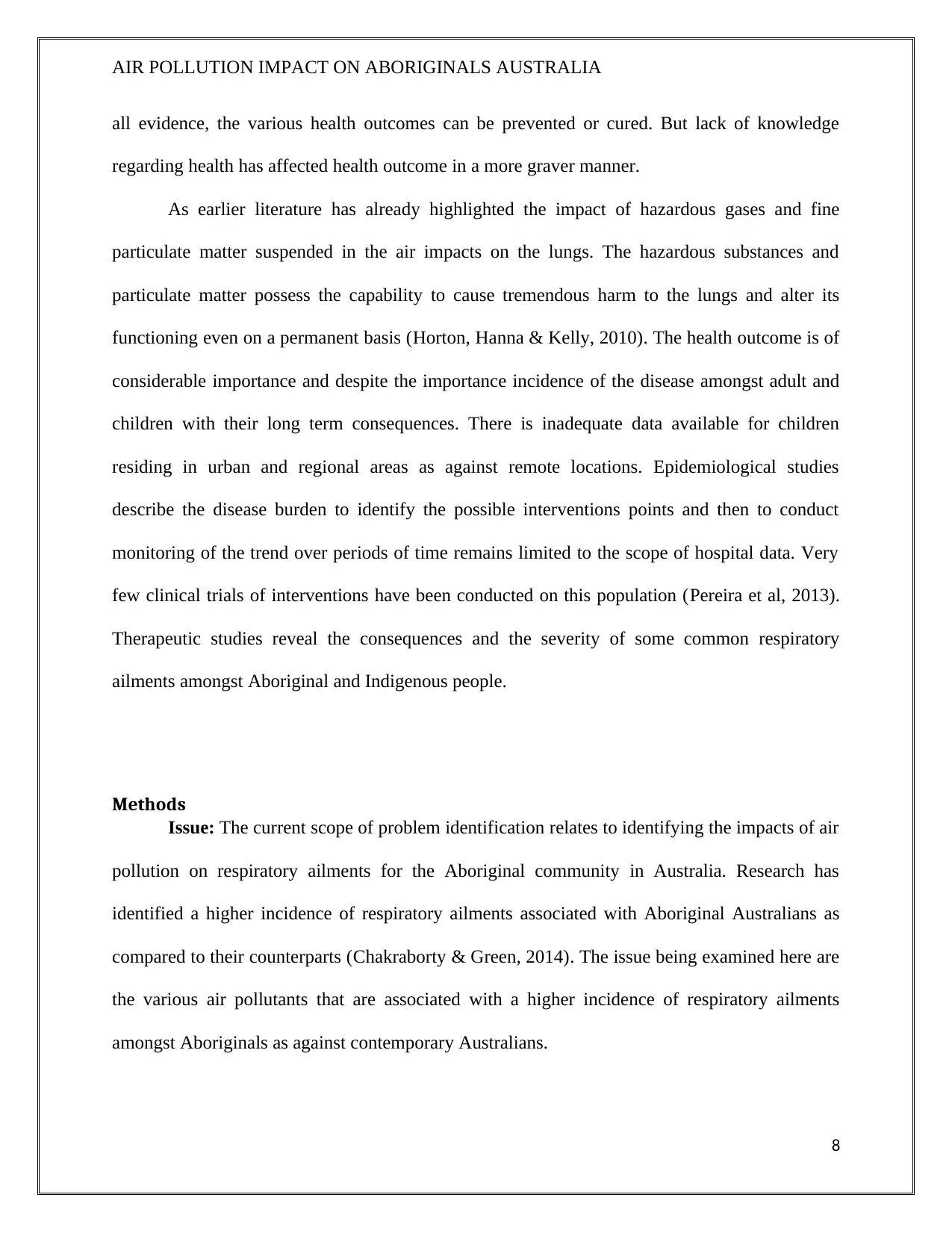
AIR POLLUTION IMPACT ON ABORIGINALS AUSTRALIA
all evidence, the various health outcomes can be prevented or cured. But lack of knowledge
regarding health has affected health outcome in a more graver manner.
As earlier literature has already highlighted the impact of hazardous gases and fine
particulate matter suspended in the air impacts on the lungs. The hazardous substances and
particulate matter possess the capability to cause tremendous harm to the lungs and alter its
functioning even on a permanent basis (Horton, Hanna & Kelly, 2010). The health outcome is of
considerable importance and despite the importance incidence of the disease amongst adult and
children with their long term consequences. There is inadequate data available for children
residing in urban and regional areas as against remote locations. Epidemiological studies
describe the disease burden to identify the possible interventions points and then to conduct
monitoring of the trend over periods of time remains limited to the scope of hospital data. Very
few clinical trials of interventions have been conducted on this population (Pereira et al, 2013).
Therapeutic studies reveal the consequences and the severity of some common respiratory
ailments amongst Aboriginal and Indigenous people.
Methods
Issue: The current scope of problem identification relates to identifying the impacts of air
pollution on respiratory ailments for the Aboriginal community in Australia. Research has
identified a higher incidence of respiratory ailments associated with Aboriginal Australians as
compared to their counterparts (Chakraborty & Green, 2014). The issue being examined here are
the various air pollutants that are associated with a higher incidence of respiratory ailments
amongst Aboriginals as against contemporary Australians.
8
all evidence, the various health outcomes can be prevented or cured. But lack of knowledge
regarding health has affected health outcome in a more graver manner.
As earlier literature has already highlighted the impact of hazardous gases and fine
particulate matter suspended in the air impacts on the lungs. The hazardous substances and
particulate matter possess the capability to cause tremendous harm to the lungs and alter its
functioning even on a permanent basis (Horton, Hanna & Kelly, 2010). The health outcome is of
considerable importance and despite the importance incidence of the disease amongst adult and
children with their long term consequences. There is inadequate data available for children
residing in urban and regional areas as against remote locations. Epidemiological studies
describe the disease burden to identify the possible interventions points and then to conduct
monitoring of the trend over periods of time remains limited to the scope of hospital data. Very
few clinical trials of interventions have been conducted on this population (Pereira et al, 2013).
Therapeutic studies reveal the consequences and the severity of some common respiratory
ailments amongst Aboriginal and Indigenous people.
Methods
Issue: The current scope of problem identification relates to identifying the impacts of air
pollution on respiratory ailments for the Aboriginal community in Australia. Research has
identified a higher incidence of respiratory ailments associated with Aboriginal Australians as
compared to their counterparts (Chakraborty & Green, 2014). The issue being examined here are
the various air pollutants that are associated with a higher incidence of respiratory ailments
amongst Aboriginals as against contemporary Australians.
8
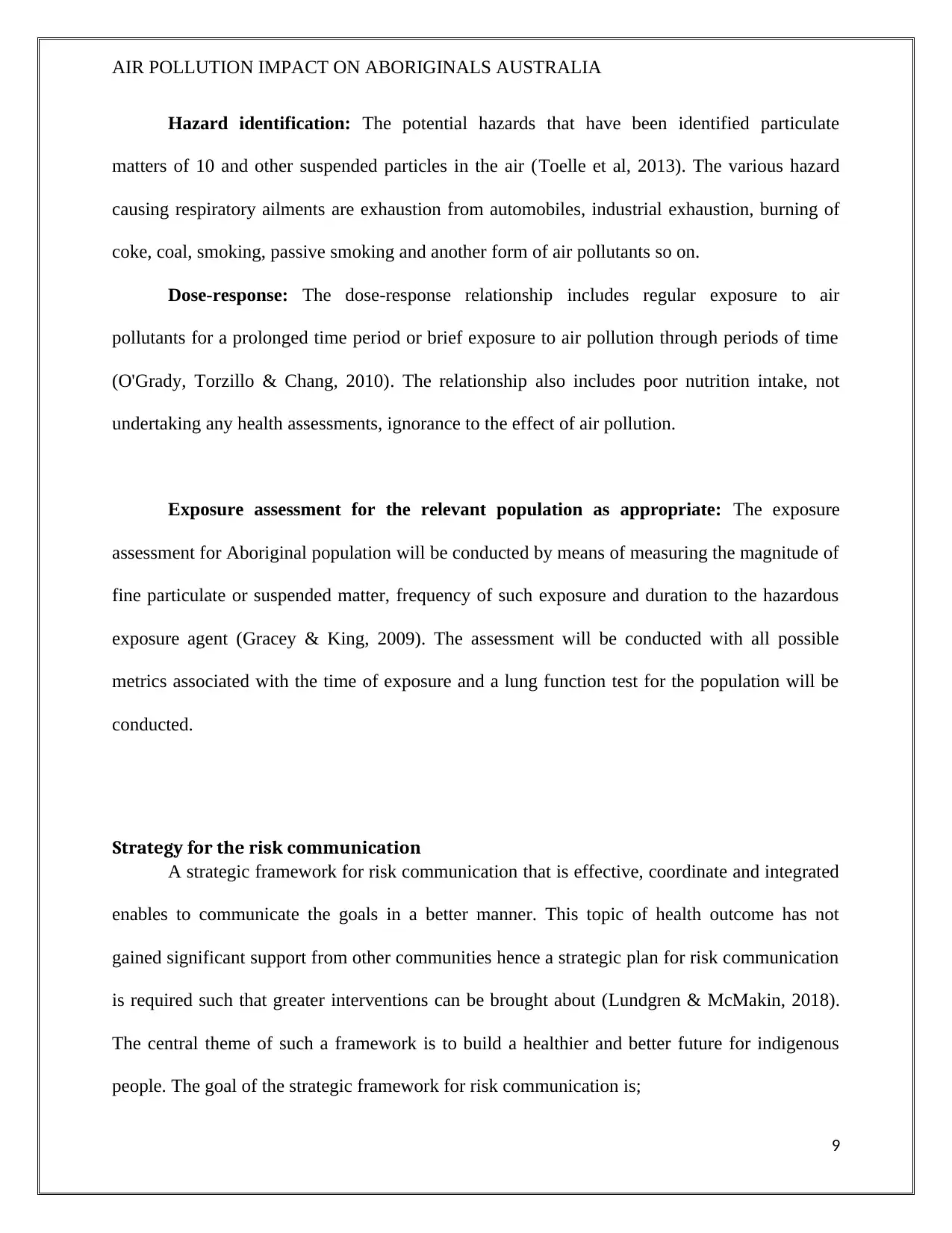
AIR POLLUTION IMPACT ON ABORIGINALS AUSTRALIA
Hazard identification: The potential hazards that have been identified particulate
matters of 10 and other suspended particles in the air (Toelle et al, 2013). The various hazard
causing respiratory ailments are exhaustion from automobiles, industrial exhaustion, burning of
coke, coal, smoking, passive smoking and another form of air pollutants so on.
Dose-response: The dose-response relationship includes regular exposure to air
pollutants for a prolonged time period or brief exposure to air pollution through periods of time
(O'Grady, Torzillo & Chang, 2010). The relationship also includes poor nutrition intake, not
undertaking any health assessments, ignorance to the effect of air pollution.
Exposure assessment for the relevant population as appropriate: The exposure
assessment for Aboriginal population will be conducted by means of measuring the magnitude of
fine particulate or suspended matter, frequency of such exposure and duration to the hazardous
exposure agent (Gracey & King, 2009). The assessment will be conducted with all possible
metrics associated with the time of exposure and a lung function test for the population will be
conducted.
Strategy for the risk communication
A strategic framework for risk communication that is effective, coordinate and integrated
enables to communicate the goals in a better manner. This topic of health outcome has not
gained significant support from other communities hence a strategic plan for risk communication
is required such that greater interventions can be brought about (Lundgren & McMakin, 2018).
The central theme of such a framework is to build a healthier and better future for indigenous
people. The goal of the strategic framework for risk communication is;
9
Hazard identification: The potential hazards that have been identified particulate
matters of 10 and other suspended particles in the air (Toelle et al, 2013). The various hazard
causing respiratory ailments are exhaustion from automobiles, industrial exhaustion, burning of
coke, coal, smoking, passive smoking and another form of air pollutants so on.
Dose-response: The dose-response relationship includes regular exposure to air
pollutants for a prolonged time period or brief exposure to air pollution through periods of time
(O'Grady, Torzillo & Chang, 2010). The relationship also includes poor nutrition intake, not
undertaking any health assessments, ignorance to the effect of air pollution.
Exposure assessment for the relevant population as appropriate: The exposure
assessment for Aboriginal population will be conducted by means of measuring the magnitude of
fine particulate or suspended matter, frequency of such exposure and duration to the hazardous
exposure agent (Gracey & King, 2009). The assessment will be conducted with all possible
metrics associated with the time of exposure and a lung function test for the population will be
conducted.
Strategy for the risk communication
A strategic framework for risk communication that is effective, coordinate and integrated
enables to communicate the goals in a better manner. This topic of health outcome has not
gained significant support from other communities hence a strategic plan for risk communication
is required such that greater interventions can be brought about (Lundgren & McMakin, 2018).
The central theme of such a framework is to build a healthier and better future for indigenous
people. The goal of the strategic framework for risk communication is;
9
⊘ This is a preview!⊘
Do you want full access?
Subscribe today to unlock all pages.

Trusted by 1+ million students worldwide
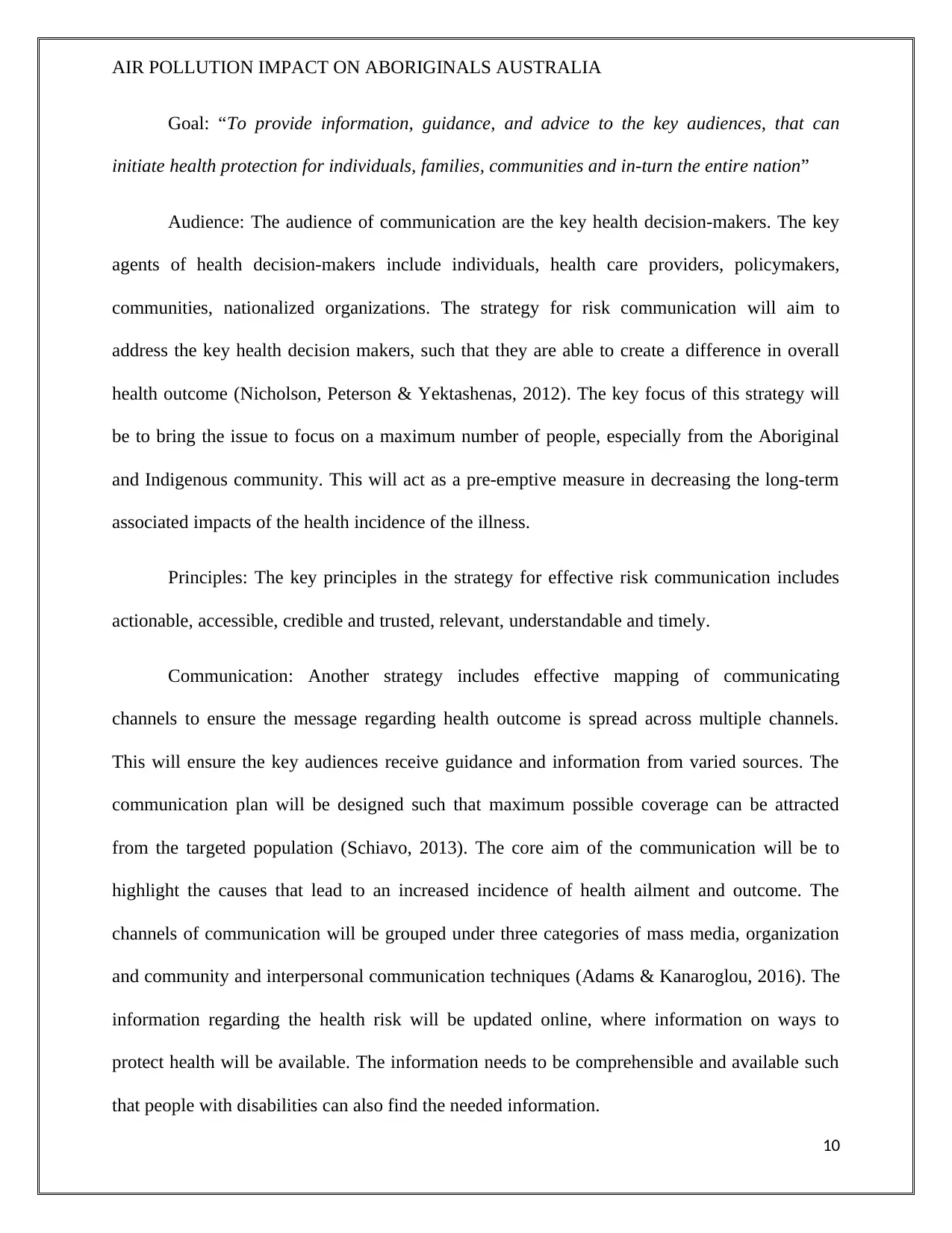
AIR POLLUTION IMPACT ON ABORIGINALS AUSTRALIA
Goal: “To provide information, guidance, and advice to the key audiences, that can
initiate health protection for individuals, families, communities and in-turn the entire nation”
Audience: The audience of communication are the key health decision-makers. The key
agents of health decision-makers include individuals, health care providers, policymakers,
communities, nationalized organizations. The strategy for risk communication will aim to
address the key health decision makers, such that they are able to create a difference in overall
health outcome (Nicholson, Peterson & Yektashenas, 2012). The key focus of this strategy will
be to bring the issue to focus on a maximum number of people, especially from the Aboriginal
and Indigenous community. This will act as a pre-emptive measure in decreasing the long-term
associated impacts of the health incidence of the illness.
Principles: The key principles in the strategy for effective risk communication includes
actionable, accessible, credible and trusted, relevant, understandable and timely.
Communication: Another strategy includes effective mapping of communicating
channels to ensure the message regarding health outcome is spread across multiple channels.
This will ensure the key audiences receive guidance and information from varied sources. The
communication plan will be designed such that maximum possible coverage can be attracted
from the targeted population (Schiavo, 2013). The core aim of the communication will be to
highlight the causes that lead to an increased incidence of health ailment and outcome. The
channels of communication will be grouped under three categories of mass media, organization
and community and interpersonal communication techniques (Adams & Kanaroglou, 2016). The
information regarding the health risk will be updated online, where information on ways to
protect health will be available. The information needs to be comprehensible and available such
that people with disabilities can also find the needed information.
10
Goal: “To provide information, guidance, and advice to the key audiences, that can
initiate health protection for individuals, families, communities and in-turn the entire nation”
Audience: The audience of communication are the key health decision-makers. The key
agents of health decision-makers include individuals, health care providers, policymakers,
communities, nationalized organizations. The strategy for risk communication will aim to
address the key health decision makers, such that they are able to create a difference in overall
health outcome (Nicholson, Peterson & Yektashenas, 2012). The key focus of this strategy will
be to bring the issue to focus on a maximum number of people, especially from the Aboriginal
and Indigenous community. This will act as a pre-emptive measure in decreasing the long-term
associated impacts of the health incidence of the illness.
Principles: The key principles in the strategy for effective risk communication includes
actionable, accessible, credible and trusted, relevant, understandable and timely.
Communication: Another strategy includes effective mapping of communicating
channels to ensure the message regarding health outcome is spread across multiple channels.
This will ensure the key audiences receive guidance and information from varied sources. The
communication plan will be designed such that maximum possible coverage can be attracted
from the targeted population (Schiavo, 2013). The core aim of the communication will be to
highlight the causes that lead to an increased incidence of health ailment and outcome. The
channels of communication will be grouped under three categories of mass media, organization
and community and interpersonal communication techniques (Adams & Kanaroglou, 2016). The
information regarding the health risk will be updated online, where information on ways to
protect health will be available. The information needs to be comprehensible and available such
that people with disabilities can also find the needed information.
10
Paraphrase This Document
Need a fresh take? Get an instant paraphrase of this document with our AI Paraphraser

AIR POLLUTION IMPACT ON ABORIGINALS AUSTRALIA
The health outcome needs to be spread across multiple communication channels that
allow targeting a broad range of audiences. Using regional and country office channels for
reaching out to target audience with an appropriate message can enhance the effectiveness of
message spread (D'Amato, Cecchi, D'amato & Liccardi, 2010). Spreading the message through
national, regional and local news media, social media websites with local and regional followers,
websites, interpersonal and community networks as well as partnering with channels can help
coordinate the message. In order to spread the message across varied channels of communication
traditional as well as contemporary methods will be used. These methods will ensure maximum
possible outreach to the targeted population. Though the policymakers have designed a number
of policies for the targeted health outcome, yet there is a lack of awareness regarding these
policies as well (Kreuter, Farrell, Olevitch & Brennan, 2013). Hence, the communication plan
will include social media communication along with traditional methods such as banners,
posters, pamphlet distribution and event one-to-one interaction to enable maximum possible
outreach to agents of change.
All the communications regarding the environmental risks will ensure the
communications are actionable. Planning appropriate questions with the communication will
ensure that all communications made are actionable in nature (Fagerlin, Zikmund-Fisher & Ubel,
2011). This will not only help increase awareness but also provide benefits to overcome barriers.
Campaigning: Designing a behavioral change campaign is key to the strategy of risk
communication. The behavioral change campaign will involve partners and ensure the
availability of community resources in sending the message.
11
The health outcome needs to be spread across multiple communication channels that
allow targeting a broad range of audiences. Using regional and country office channels for
reaching out to target audience with an appropriate message can enhance the effectiveness of
message spread (D'Amato, Cecchi, D'amato & Liccardi, 2010). Spreading the message through
national, regional and local news media, social media websites with local and regional followers,
websites, interpersonal and community networks as well as partnering with channels can help
coordinate the message. In order to spread the message across varied channels of communication
traditional as well as contemporary methods will be used. These methods will ensure maximum
possible outreach to the targeted population. Though the policymakers have designed a number
of policies for the targeted health outcome, yet there is a lack of awareness regarding these
policies as well (Kreuter, Farrell, Olevitch & Brennan, 2013). Hence, the communication plan
will include social media communication along with traditional methods such as banners,
posters, pamphlet distribution and event one-to-one interaction to enable maximum possible
outreach to agents of change.
All the communications regarding the environmental risks will ensure the
communications are actionable. Planning appropriate questions with the communication will
ensure that all communications made are actionable in nature (Fagerlin, Zikmund-Fisher & Ubel,
2011). This will not only help increase awareness but also provide benefits to overcome barriers.
Campaigning: Designing a behavioral change campaign is key to the strategy of risk
communication. The behavioral change campaign will involve partners and ensure the
availability of community resources in sending the message.
11
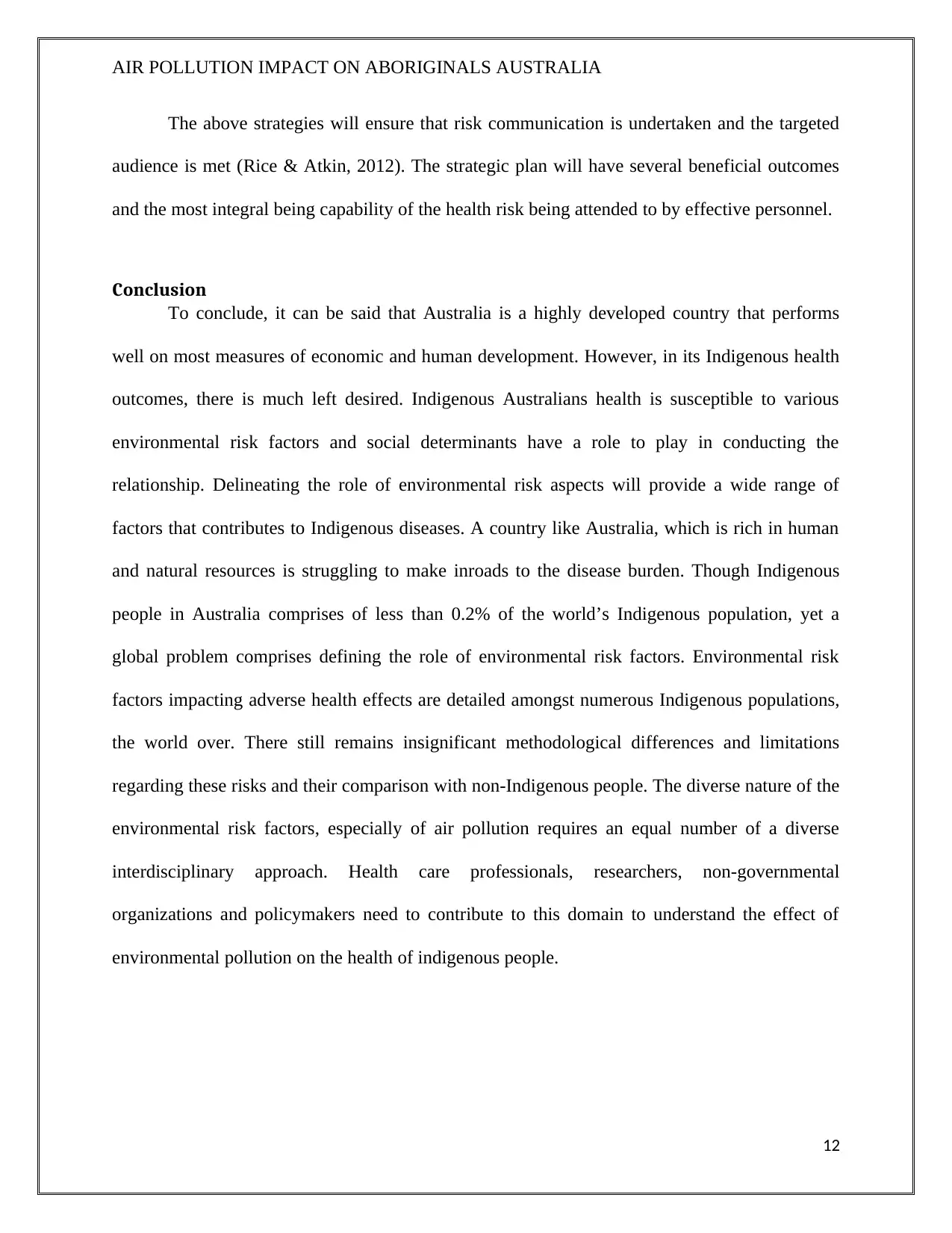
AIR POLLUTION IMPACT ON ABORIGINALS AUSTRALIA
The above strategies will ensure that risk communication is undertaken and the targeted
audience is met (Rice & Atkin, 2012). The strategic plan will have several beneficial outcomes
and the most integral being capability of the health risk being attended to by effective personnel.
Conclusion
To conclude, it can be said that Australia is a highly developed country that performs
well on most measures of economic and human development. However, in its Indigenous health
outcomes, there is much left desired. Indigenous Australians health is susceptible to various
environmental risk factors and social determinants have a role to play in conducting the
relationship. Delineating the role of environmental risk aspects will provide a wide range of
factors that contributes to Indigenous diseases. A country like Australia, which is rich in human
and natural resources is struggling to make inroads to the disease burden. Though Indigenous
people in Australia comprises of less than 0.2% of the world’s Indigenous population, yet a
global problem comprises defining the role of environmental risk factors. Environmental risk
factors impacting adverse health effects are detailed amongst numerous Indigenous populations,
the world over. There still remains insignificant methodological differences and limitations
regarding these risks and their comparison with non-Indigenous people. The diverse nature of the
environmental risk factors, especially of air pollution requires an equal number of a diverse
interdisciplinary approach. Health care professionals, researchers, non-governmental
organizations and policymakers need to contribute to this domain to understand the effect of
environmental pollution on the health of indigenous people.
12
The above strategies will ensure that risk communication is undertaken and the targeted
audience is met (Rice & Atkin, 2012). The strategic plan will have several beneficial outcomes
and the most integral being capability of the health risk being attended to by effective personnel.
Conclusion
To conclude, it can be said that Australia is a highly developed country that performs
well on most measures of economic and human development. However, in its Indigenous health
outcomes, there is much left desired. Indigenous Australians health is susceptible to various
environmental risk factors and social determinants have a role to play in conducting the
relationship. Delineating the role of environmental risk aspects will provide a wide range of
factors that contributes to Indigenous diseases. A country like Australia, which is rich in human
and natural resources is struggling to make inroads to the disease burden. Though Indigenous
people in Australia comprises of less than 0.2% of the world’s Indigenous population, yet a
global problem comprises defining the role of environmental risk factors. Environmental risk
factors impacting adverse health effects are detailed amongst numerous Indigenous populations,
the world over. There still remains insignificant methodological differences and limitations
regarding these risks and their comparison with non-Indigenous people. The diverse nature of the
environmental risk factors, especially of air pollution requires an equal number of a diverse
interdisciplinary approach. Health care professionals, researchers, non-governmental
organizations and policymakers need to contribute to this domain to understand the effect of
environmental pollution on the health of indigenous people.
12
⊘ This is a preview!⊘
Do you want full access?
Subscribe today to unlock all pages.

Trusted by 1+ million students worldwide
1 out of 15
Related Documents
Your All-in-One AI-Powered Toolkit for Academic Success.
+13062052269
info@desklib.com
Available 24*7 on WhatsApp / Email
![[object Object]](/_next/static/media/star-bottom.7253800d.svg)
Unlock your academic potential
Copyright © 2020–2025 A2Z Services. All Rights Reserved. Developed and managed by ZUCOL.





